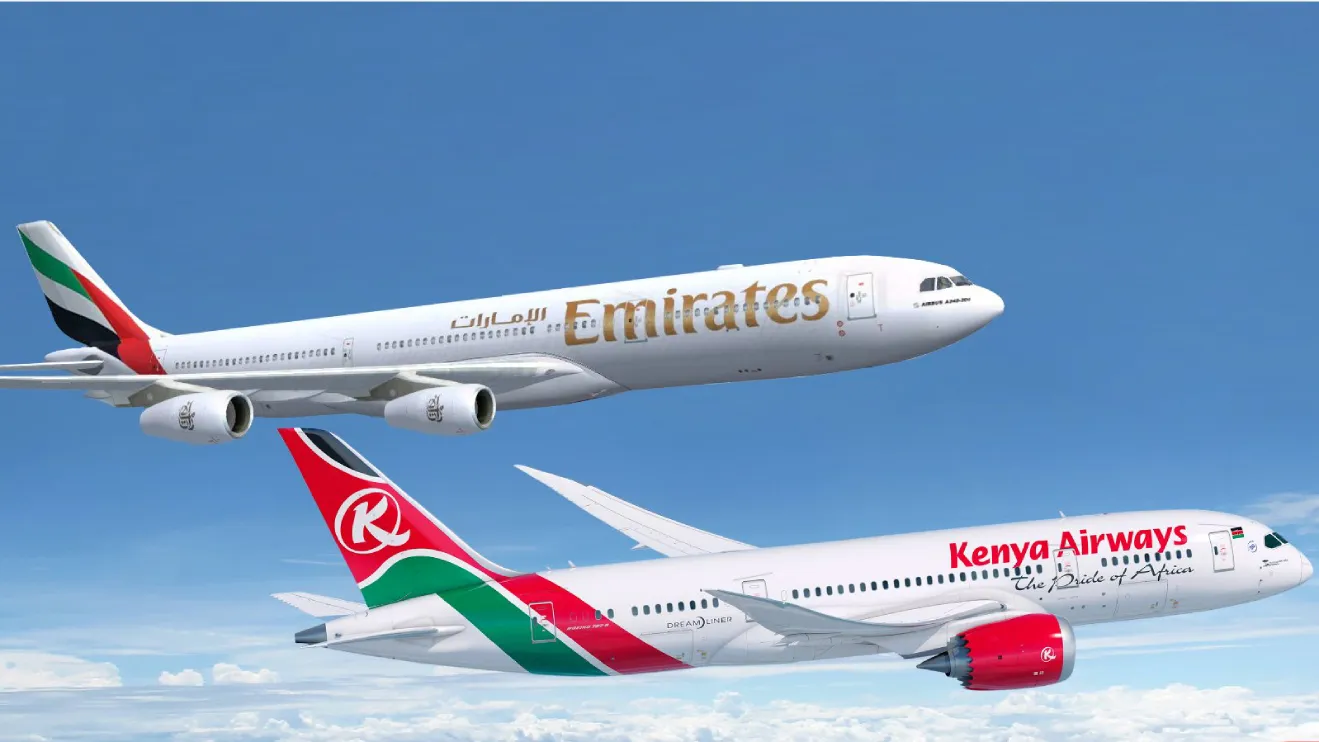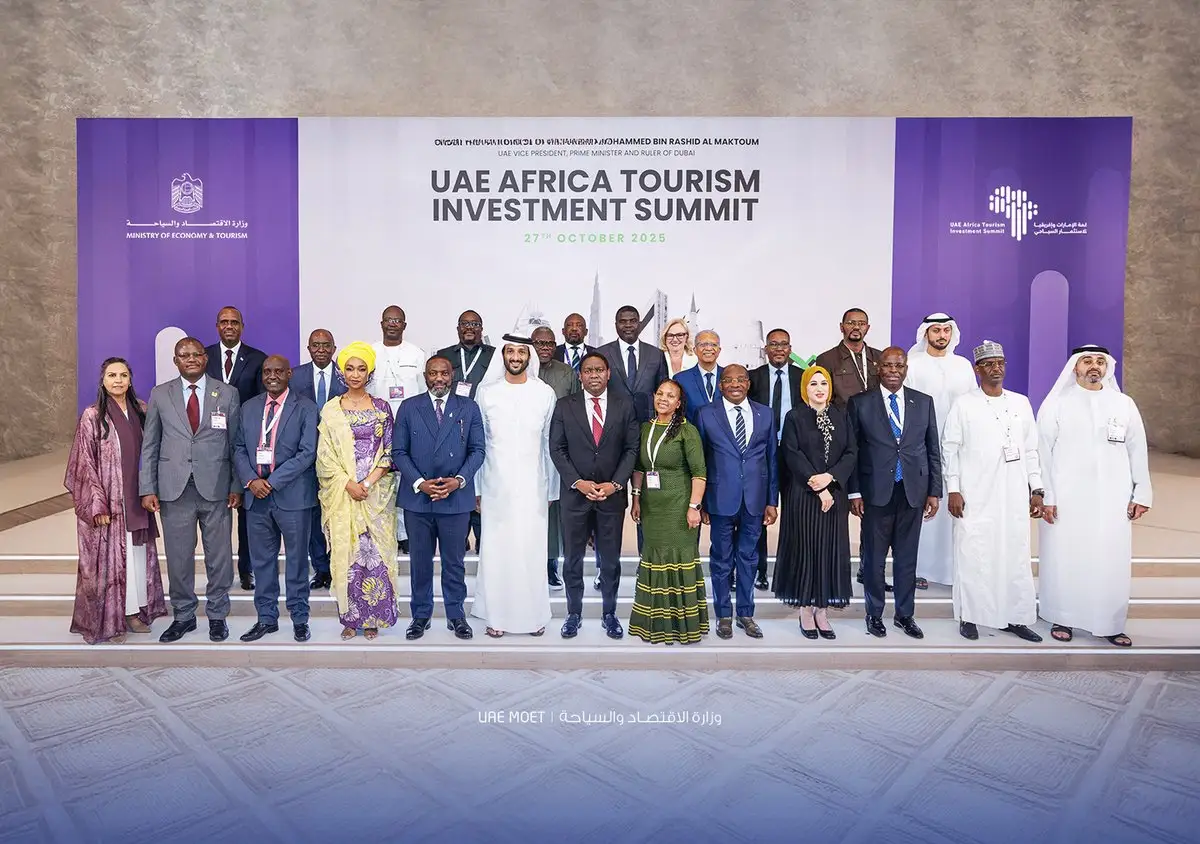Emirates Airlines is strategically positioning Kenya as its primary gateway to East and Central Africa, capitalizing on the recently implemented Kenya-UAE Comprehensive Economic Partnership Agreement (CEPA) and an expanding commercial partnership with Kenya Airways to unlock new opportunities in passenger travel, cargo operations, and regional connectivity. As the Dubai-based carrier celebrates three decades of operations in Kenya, its leadership has outlined an ambitious vision that places Nairobi at the center of the airline’s African growth strategy.
Build the future you deserve. Get started with our top-tier Online courses: ACCA, HESI A2, ATI TEAS 7, HESI EXIT, NCLEX-RN, NCLEX-PN, and Financial Literacy. Let Serrari Ed guide your path to success. Enroll today.
The CEPA Framework: A New Era of Kenya-UAE Economic Relations
The foundation of Emirates’ expanded Kenya strategy rests on the Comprehensive Economic Partnership Agreement between Kenya and the United Arab Emirates, a landmark bilateral trade pact signed in 2024 that fundamentally reshapes economic relations between the two nations. Christophe Leloup, Emirates’ Country Manager for Kenya, emphasized that this agreement represents far more than a routine trade deal—it establishes a comprehensive framework designed to eliminate trade barriers, accelerate investment flows, and dramatically increase the volume of Kenyan exports to Gulf markets.
“The CEPA is a major milestone between Kenya and the UAE. Both countries are looking to boost trade, business, and tourism over the next five years, and Emirates is playing a central role in facilitating those connections,” Leloup stated during a roundtable discussion in Nairobi commemorating Emirates’ 30th anniversary of service to Kenya.
The CEPA agreement targets multiple dimensions of economic cooperation. Beyond traditional tariff reductions, the pact includes provisions for streamlined customs procedures, mutual recognition of standards and certifications, enhanced protection for investments, and frameworks for cooperation in emerging sectors including technology, renewable energy, and logistics. For Emirates, these provisions translate directly into expanded business opportunities, as reduced trade friction and increased bilateral commerce naturally generate demand for both passenger and cargo air services.
The timing of CEPA’s implementation coincides with Kenya’s broader efforts to position itself as East Africa’s preeminent trade and logistics hub. The Port of Mombasa, already the region’s largest seaport, serves as the primary gateway for goods destined for Kenya, Uganda, Rwanda, Burundi, South Sudan, and eastern Democratic Republic of Congo. By combining maritime connectivity through Mombasa with air connectivity through Jomo Kenyatta International Airport in Nairobi, Kenya offers a comprehensive logistics platform that Emirates is well-positioned to leverage.
Cargo Operations: The Backbone of Emirates’ Kenya Strategy
While passenger services often receive the spotlight in airline operations, Emirates’ cargo division represents a critical—and highly profitable—component of its Kenya business model. The scale of this operation became clear when Leloup revealed that in 2024 alone, Emirates transported over 16,000 tons of Kenyan flowers to global markets, in addition to substantial volumes of fresh fruits, vegetables, and meat products.
Kenya’s floriculture industry ranks among the world’s largest flower exporters, with the sector generating over $1 billion in annual export revenues and providing employment to approximately 500,000 Kenyans. The country supplies roughly one-third of all flowers sold in the European Union, with roses, carnations, and summer flowers grown primarily around Lake Naivasha and in the highlands surrounding Mount Kenya. The industry’s success depends entirely on rapid, reliable air cargo services that can transport highly perishable products from Kenyan farms to European flower markets within 24-48 hours.
Emirates currently operates three weekly dedicated freighter flights between Nairobi and Europe, utilizing Boeing 777F aircraft that offer substantial cargo capacity and the reliability essential for perishable goods transport. These freighter services complement the belly-hold cargo capacity available on Emirates’ passenger flights, creating a comprehensive cargo network that serves diverse shipper requirements.
The CEPA agreement is expected to significantly expand Emirates’ cargo operations beyond the traditional Kenya-Europe corridors. Leloup indicated that the airline anticipates substantial growth in cargo flows between Kenya and the UAE, as Kenyan agricultural exporters, manufacturers, and processors increasingly target Middle Eastern markets. The UAE, particularly Dubai, functions not just as a destination market but as a global cargo hub, with Dubai International Airport and the adjacent Al Maktoum International Airport offering connections to markets throughout Asia, the Middle East, and beyond.
This cargo dimension holds particular significance for Kenya’s economic development strategy. The Kenya Vision 2030 development blueprint identifies manufacturing and agricultural value-addition as key pillars of economic transformation, with both sectors requiring efficient cargo logistics to access international markets. Emirates’ expanded cargo services directly support these strategic objectives by providing Kenyan producers with reliable access to lucrative export markets.
The Kenya Airways Partnership: Expanding African Connectivity
Parallel to its cargo expansion, Emirates has developed a strategic partnership with Kenya Airways that is reshaping air travel patterns across East and Central Africa. The interline agreement, formalized in 2023, allows passengers to book seamless journeys combining flights on both carriers under a single ticket, with coordinated schedules, through baggage handling, and streamlined connections at Nairobi’s Jomo Kenyatta International Airport.
The partnership’s scale and impact have exceeded initial expectations. Over the past two years, more than 31,000 passengers have traveled under the codeshare arrangement, with demand distributed relatively evenly between both carriers. This balanced traffic flow validates the partnership’s structure, demonstrating that it creates genuine value for both airlines rather than disproportionately benefiting one partner.
The route network enabled by this partnership illustrates its strategic value. Emirates passengers can now connect through Kenya Airways to destinations throughout East and Central Africa, including Kigali in Rwanda, Lilongwe in Malawi, Maputo in Mozambique, and Bujumbura in Burundi—markets where Emirates does not operate direct service but where significant passenger demand exists. Conversely, Kenya Airways passengers gain seamless access to Emirates’ global network of over 150 destinations, with particularly strong demand for connections to the United States, China, broader Asia, and Europe.
“The partnership with Kenya Airways is strategic,” Leloup explained. “It allows Emirates to reach destinations in Africa where we don’t operate directly, while giving KQ passengers seamless access to our global network of over 150 destinations.”
This partnership model reflects broader trends in global aviation, where major international carriers increasingly collaborate with regional carriers to achieve comprehensive network coverage without the costs and complexity of operating every route directly. For Kenya Airways, the partnership provides valuable feed traffic from Emirates’ global network, supporting load factors on Kenya Airways’ regional African routes. For Emirates, it extends the airline’s effective reach across Africa without requiring the airline to deploy aircraft and crews to lower-density regional routes that may not justify direct service.
The collaboration also positions both airlines favorably as Africa pursues greater aviation liberalization through initiatives like the Single African Air Transport Market (SAATM). As African aviation markets gradually open and intra-African connectivity improves, partnerships between major international carriers and African airlines will play crucial roles in channeling passengers between African destinations and the rest of the world.
Three Decades of Operations: Emirates’ Kenya Legacy
Emirates’ announcement of expansion plans comes as the airline marks 30 years of continuous service to Kenya, a milestone that provides perspective on the carrier’s long-term commitment to the East African market. Since launching operations in October 1995, Emirates has transported more than 6.6 million passengers to and from Kenya across over 34,000 flights, establishing itself as a fixture in Kenya’s aviation landscape and a preferred carrier for both business and leisure travelers.
Kenya holds the distinction of being Emirates’ first East African destination, preceding the airline’s subsequent expansion to Dar es Salaam, Tanzania, and other regional points. This pioneering entry into the East African market reflects Emirates’ early recognition of Kenya’s potential as both a destination and a hub for regional connectivity. Throughout three decades, Emirates has consistently maintained service to Kenya through various challenges, including economic downturns, security concerns, and the COVID-19 pandemic that devastated global aviation from 2020 to 2022.
The airline’s commitment to the Kenyan market extends beyond flight operations to significant employment creation. Emirates currently employs over 1,100 Kenyan nationals globally, including approximately 250 cabin crew members and 40 pilots. These positions offer competitive compensation, comprehensive training, international experience, and career development opportunities that make Emirates a sought-after employer among Kenyan aviation professionals. The airline’s Kenyan employees serve on Emirates flights worldwide, becoming ambassadors for both the airline and Kenya across the carrier’s global network.
Kenya’s tourism sector, a cornerstone of the national economy generating approximately 10% of GDP and supporting millions of jobs, has been a major beneficiary of Emirates’ long-term presence. The airline connects Kenya’s world-renowned attractions—including the Maasai Mara wildlife reserve, the coastal beaches of Mombasa and Malindi, and Mount Kenya—to key source markets in Europe, Asia, Australia, and the Americas. By offering convenient connections through Dubai, Emirates has helped position Kenya as an accessible destination for travelers from markets that would otherwise require complex, multi-stop journeys to reach East Africa.
One decision can change your entire career. Take that step with our Online courses in ACCA, HESI A2, ATI TEAS 7, HESI EXIT, NCLEX-RN, NCLEX-PN, and Financial Literacy. Join Serrari Ed and start building your brighter future today.
Open Skies and Aviation Liberalization: Shaping Africa’s Future
As Kenya and the broader African continent contemplate more liberalized aviation policies, Emirates has positioned itself as a strong supporter of open skies initiatives. Leloup articulated the airline’s perspective that aviation liberalization generates benefits across multiple dimensions of the aviation ecosystem and the broader economy.
“Open skies provide opportunities for business and leisure, and help reduce the cost of travel. Emirates will remain a key player in connecting Kenya to the world,” Leloup stated, endorsing Kenya’s gradual movement toward more liberalized aviation policies.
Open skies agreements, which eliminate government restrictions on airlines’ route rights, capacity, and pricing, represent a fundamental shift from the traditional bilateral air service agreements that have governed international aviation for decades. Traditional bilaterals typically limit which airlines can fly specific routes, restrict the number of flights and seats those airlines can offer, and often include provisions requiring airlines to be majority-owned by nationals of the states party to the agreement.
The Yamoussoukro Decision, adopted by African heads of state in 1999 but only gradually being implemented through the SAATM initiative, seeks to liberalize intra-African aviation. While this framework primarily addresses flights between African countries, individual African nations including Kenya are also exploring more liberal policies for intercontinental services with partners like the UAE.
For Kenya specifically, aviation liberalization offers both opportunities and challenges. As a country with relatively strong aviation infrastructure, a flag carrier with regional network reach, and position as a regional economic hub, Kenya potentially benefits from liberalization by attracting more international airlines, increasing competition that can reduce fares, and positioning Nairobi as a connecting hub for multiple carriers. However, liberalization also intensifies competitive pressure on Kenya Airways, which must compete against well-capitalized Gulf carriers including Emirates, Qatar Airways, and Etihad Airways, as well as European and Asian carriers seeking African market access.
Emirates’ support for aviation liberalization reflects the airline’s confidence in its competitive position. With strong brand recognition, an extensive global network, modern fuel-efficient aircraft, and the geographic advantage of Dubai’s position between Europe and Asia, Emirates believes it can thrive in more competitive environments where artificial restrictions no longer protect less efficient competitors.
Regional Competition and Market Dynamics
Emirates’ expansion in Kenya occurs within a highly competitive regional aviation environment. The carrier competes against other Gulf carriers, particularly Qatar Airways and Etihad Airways, which also operate services to Nairobi and view East Africa as strategically important. Ethiopian Airlines, Africa’s largest and most successful carrier, operates a competing hub model through Addis Ababa, directly competing with Emirates for passengers traveling between Africa and international destinations.
Turkish Airlines, operating through its Istanbul hub, has also aggressively expanded African services in recent years, offering competitive pricing and convenient connections between African cities and European destinations. European carriers including KLM, Air France, British Airways, and Lufthansa maintain long-established services to Nairobi, leveraging historical ties and business relationships.
Within this competitive landscape, Emirates differentiates itself through service quality, brand strength, and network breadth. The airline has consistently invested in passenger experience, from in-flight entertainment systems to cabin comfort and cuisine. Dubai’s geographic position offers efficient connections to Asia and Australasia that are often more convenient than European hub routings, giving Emirates a structural advantage for passengers traveling between Africa and Asia.
The CEPA agreement and the Kenya Airways partnership represent strategic moves designed to strengthen Emirates’ competitive position by creating unique value propositions not easily replicated by competitors. The trade facilitation dimensions of CEPA, for instance, specifically advantage Emirates in cargo operations between Kenya and UAE markets, while the Kenya Airways partnership provides African network coverage that rival carriers cannot match without developing similar partnerships or operating lower-density routes themselves.
Looking Ahead: Investment and Expansion Prospects
While Leloup’s comments focused primarily on leveraging existing operations and partnerships, the subtext clearly suggests Emirates envisions expanded Kenya operations if demand materializes as expected under CEPA and the Kenya Airways partnership. The airline’s reference to growing capacity “as passenger and cargo demand increases” indicates that additional frequencies, potentially larger aircraft, or new service patterns may emerge in coming years.
Several factors will likely influence Emirates’ Kenya expansion decisions. The pace of CEPA implementation and the actual increase in bilateral trade volumes will determine cargo demand growth. The success of the Kenya Airways partnership in generating additional traffic will affect passenger service requirements. Infrastructure developments at Jomo Kenyatta International Airport, including planned terminal expansions and improvements, will impact operational capabilities. And broader economic conditions in Kenya, the UAE, and key source markets will shape underlying travel demand.
Kenya’s own aviation infrastructure investments, including plans to potentially develop a new international airport to supplement or eventually replace the aging JKIA facility, could significantly affect Emirates’ long-term Kenya strategy. A modern, efficient airport with ample capacity and superior passenger experience would enhance Nairobi’s attractiveness as a connecting hub, benefiting all airlines serving the airport but particularly carriers like Emirates that rely on efficient connections between flights.
Conclusion: Strategic Partnership for Mutual Prosperity
Emirates’ expanded Kenya strategy, built on the foundation of the Kenya-UAE CEPA agreement and the partnership with Kenya Airways, represents a sophisticated approach to market development that transcends traditional airline business models. By integrating passenger services, cargo operations, and strategic partnerships within a framework of deepening economic relations between Kenya and the UAE, Emirates has positioned itself to capture substantial value from the growth anticipated over the coming decade.
For Kenya, the Emirates partnership and the broader CEPA framework offer tangible benefits: expanded market access for agricultural exports, improved connectivity for business travelers and tourists, competitive pressure that can reduce travel costs, and foreign investment in aviation infrastructure and services. As Kenya pursues its Vision 2030 development objectives and seeks to leverage the opportunities created by the African Continental Free Trade Area, partnerships with major international carriers like Emirates provide critical enablers of economic growth and integration.
Three decades after Emirates first landed in Nairobi, the airline’s commitment to the Kenyan market appears stronger than ever, with the next chapter of this partnership poised to deliver mutual benefits for both the carrier and the country it serves.
Ready to take your career to the next level? Join our Online courses: ACCA, HESI A2, ATI TEAS 7 , HESI EXIT , NCLEX – RN and NCLEX – PN, Financial Literacy!🌟 Dive into a world of opportunities and empower yourself for success. Explore more at Serrari Ed and start your exciting journey today! ✨
Track GDP, Inflation and Central Bank rates for top African markets with Serrari’s comparator tool.
See today’s Treasury bonds and Money market funds movement across financial service providers in Kenya, using Serrari’s comparator tools.
Photo source: Google
By: Montel Kamau
Serrari Financial Analyst
30th October, 2025
Article, Financial and News Disclaimer
The Value of a Financial Advisor
While this article offers valuable insights, it is essential to recognize that personal finance can be highly complex and unique to each individual. A financial advisor provides professional expertise and personalized guidance to help you make well-informed decisions tailored to your specific circumstances and goals.
Beyond offering knowledge, a financial advisor serves as a trusted partner to help you stay disciplined, avoid common pitfalls, and remain focused on your long-term objectives. Their perspective and experience can complement your own efforts, enhancing your financial well-being and ensuring a more confident approach to managing your finances.
Disclaimer: This article is for informational purposes only and does not constitute financial advice. Readers are encouraged to consult a licensed financial advisor to obtain guidance specific to their financial situation.
Article and News Disclaimer
The information provided on www.serrarigroup.com is for general informational purposes only. While we strive to keep the information up to date and accurate, we make no representations or warranties of any kind, express or implied, about the completeness, accuracy, reliability, suitability, or availability with respect to the website or the information, products, services, or related graphics contained on the website for any purpose. Any reliance you place on such information is therefore strictly at your own risk.
www.serrarigroup.com is not responsible for any errors or omissions, or for the results obtained from the use of this information. All information on the website is provided on an as-is basis, with no guarantee of completeness, accuracy, timeliness, or of the results obtained from the use of this information, and without warranty of any kind, express or implied, including but not limited to warranties of performance, merchantability, and fitness for a particular purpose.
In no event will www.serrarigroup.com be liable to you or anyone else for any decision made or action taken in reliance on the information provided on the website or for any consequential, special, or similar damages, even if advised of the possibility of such damages.
The articles, news, and information presented on www.serrarigroup.com reflect the opinions of the respective authors and contributors and do not necessarily represent the views of the website or its management. Any views or opinions expressed are solely those of the individual authors and do not represent the website's views or opinions as a whole.
The content on www.serrarigroup.com may include links to external websites, which are provided for convenience and informational purposes only. We have no control over the nature, content, and availability of those sites. The inclusion of any links does not necessarily imply a recommendation or endorsement of the views expressed within them.
Every effort is made to keep the website up and running smoothly. However, www.serrarigroup.com takes no responsibility for, and will not be liable for, the website being temporarily unavailable due to technical issues beyond our control.
Please note that laws, regulations, and information can change rapidly, and we advise you to conduct further research and seek professional advice when necessary.
By using www.serrarigroup.com, you agree to this disclaimer and its terms. If you do not agree with this disclaimer, please do not use the website.
www.serrarigroup.com, reserves the right to update, modify, or remove any part of this disclaimer without prior notice. It is your responsibility to review this disclaimer periodically for changes.
Serrari Group 2025











